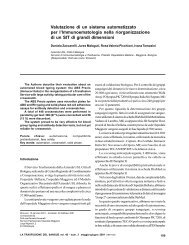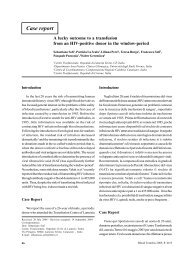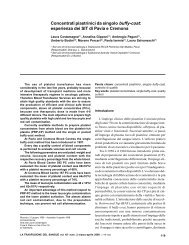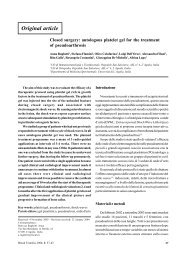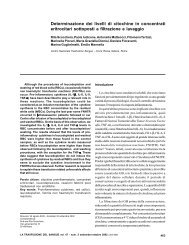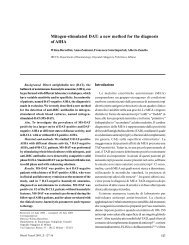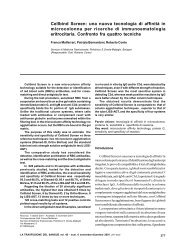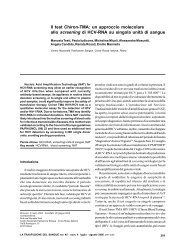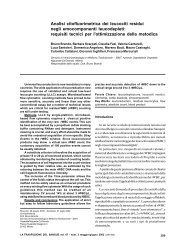Reverberi R , Reverberi LIt is easy to see that after n cycles:Residual fraction s = 1 − (2). kV When blood is first transfused, on the basis of verysimilar considerations to those above, it can be derivedthat:Residual fraction= ns − k(V + s)1 (3).In the above formulae, only the correction for thedifference between venous <strong>and</strong> body haematocrit was used.However, a further correction is advisable when thehaematocrit is measured by centrifugation because of thesmall amount of plasma (≈ 2%) that remains entrapped inthe red cell column 8 . In this case k = 0.91 x 0.98 = 0.89.Absolute amount of neonatal red cellsremaining after the exchange <strong>transfusion</strong>The volume of the neonatal red cells remaining afterthe exchange cycles (R R) can be derived from formula (2):nR Bcan be derived from (1). The removed volume can beeasily calculated by difference.Venous haematocrit after the exchange<strong>transfusion</strong>Let us consider the case in which blood is firstswithdrawn. Let a = <strong>and</strong> b =1 − a .kVAt each cycle, a fraction equal to a of the donor's redcells present in the circulation will be removed, whilst avolume D Swill be added.Table II shows the situation in the first cycles of anexchange <strong>transfusion</strong>.As can be seen from the far right column, at each cycle,a term to the power n – 1 is added in parentheses.By definition, we know that:HD=DsSDS× 100 = × 100kV( 1 − b)where H Dis the haematocrit of the transfused blood, <strong>and</strong>that:2n−1DSHd= ( 1+b + b + ... + b ) × × 100 ,kVRR s = RB× 1 − , kV nwhere H dis the venous haematocrit (in the patient’scirculation) of the transfused red cells after cycle n.Therefore:or formula (3), as appropriate:d2n−1n( 1 − b) × ( 1 + b+b + ... + b ) × HD= ( 1 − b ) HDH =×RR=RB× s − k(V + s)1 ,nTable II - Volumes of donor red cells (V GR) exchanged during the exchange <strong>transfusion</strong>. At each cycle, blood is first withdrawn <strong>and</strong>then transfused. In the first cycle, no donor red cells are in the circulation during the withdrawal step. D Sis the volumeof donor red cells transfused at each cycleWithdrawal step<strong>Transfusion</strong> stepCYCLE Removed V GRRemaining V GRFinal V GR1 0 0 D S2 a × D Sb × D SD S+ b × D S3 a × (1 + b) × D S(b + b 2 ) × D S(1 + b + b 2 ) × D S4 a × (1 + b + b 2 ) × D S(b + b 2 + b 3 ) × D S(1 + b + b 2 + b 3 ) × D S… … … …n a × (1 + b + b 2 +…+ b n-2 ) × D S(b + b 2 +…+ b n-1 ) × D S(1 + b + b 2 +…+ b n-1 ) × D S98<strong>Blood</strong> Transfus 2007; 5: 93-101 DOI 10.2450/2007.0018-07093-101_reverberi.p65 9809/07/2007, 9.53
Removal kinetics of exchange <strong>transfusion</strong>By substitution, the following formula is obtained:Hd = 1 ×kV n s 1 − − HD .In the same way, we can derive the venous haematocritof the patient’s red cells after the exchange <strong>transfusion</strong>(H p): s Hp = 1 − × HV. kV Therefore, at the end of n cycles of exchange <strong>transfusion</strong>,the total venous haematocrit will be the sum of the twopartial ones 7 :nAppendix B – Programming a spreadsheet*Spreadsheets are programmes used to performcalculations, especially on large data series.The most renowned is Excel, which is part of the MSOffice (Microsoft) package.However, the following instructions are equally validfor other similar programmes, such as OpenOffice.org Calc<strong>and</strong> Gnumeric. As these are less well known, here is a briefdescription.OpenOffice.org CalcThis is part of the OpenOffice.org suite. It is freelydownloadable from http://www.openoffice.org/ <strong>and</strong> isavailable for Windows (98 <strong>and</strong> later), Mac Os X, Linux <strong>and</strong>other operating systems. Calc can open, modify, <strong>and</strong> savefiles in Excel <strong>and</strong> other formats, besides its own native one.The available functions are similar to those of Excel. Hn = − 1 × kV kV nns sH 1 ×V + 1 − − HD.This formula allows the calculation of the venoushaematocrit of the patient during the exchange <strong>transfusion</strong>(H n), starting from the patient’s venous haematocrit beforethe procedure (H V) <strong>and</strong> the haematocrit of the transfusedblood (H D).Analogously, when blood is first transfused, thefollowing formula can be derived:nn s s H nH = 1− V × + 1 − 1− × H D k( V + s) k( V s) + .GnumericGnumeric is part of the GNU project. It can be freelydownloaded from http://www.gnome.org/projects/gnumeric/ <strong>and</strong> is available in versions for Windows (XP,2000 or later) <strong>and</strong> Linux. Gnumeric is able to open, modify<strong>and</strong> save files in Excel <strong>and</strong> other formats. Availablefunctions are similar to those of Excel but, in addition,Gnumeric offers a series of statistical tests.The following instructions only presuppose a basicknowledge of how to use a personal computer.InstructionsOpen the spreadsheet. The programme automaticallyproposes a new sheet (table), with rows progressivelynumbered starting from 1 <strong>and</strong> columns alphabeticallylabelled starting from A.Each cell is identified by a couple of column <strong>and</strong> rowidentifiers: e.g., the top leftmost cell is A1; the fourth fromtop in the B column is B4 <strong>and</strong> so on. Each cell may containnumerical values, formulae or explanatory text. This last isuseful for reminding the user of the meaning of the adjacentvalues or formulae.Calculation of the residual fraction <strong>and</strong>absolute quantity of the patient's red cellsEnter the text listed in Table III into the appropriatecells. Enter the values listed in Table IV.* Italian readers using the localized (Italian) versions of the spreadsheets shouldfollow the instructions in the Italian translation of this paper, which is availableon line at http://www.<strong>transfusion</strong><strong>medicine</strong>.org/. Briefly, "potenza" should besubstituted for "power" <strong>and</strong> ";" should be substituted for ",".<strong>Blood</strong> Transfus 2007; 5: 93-101 DOI 10.2450/2007.0018-0799093-101_reverberi.p65 9909/07/2007, 9.53



